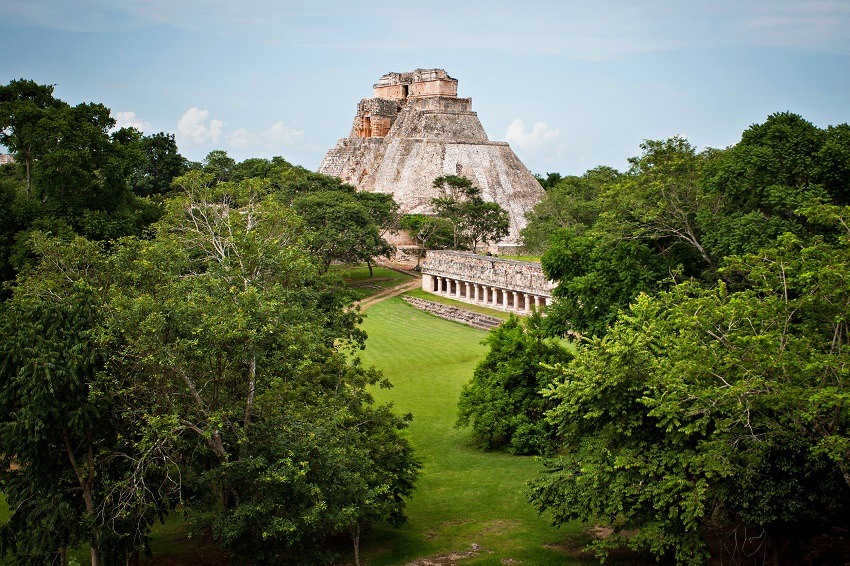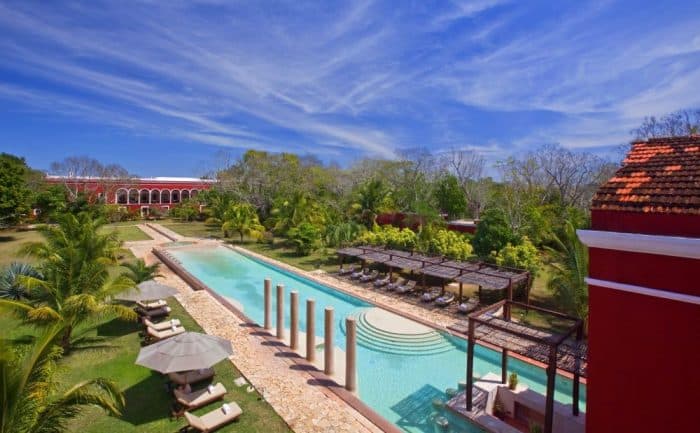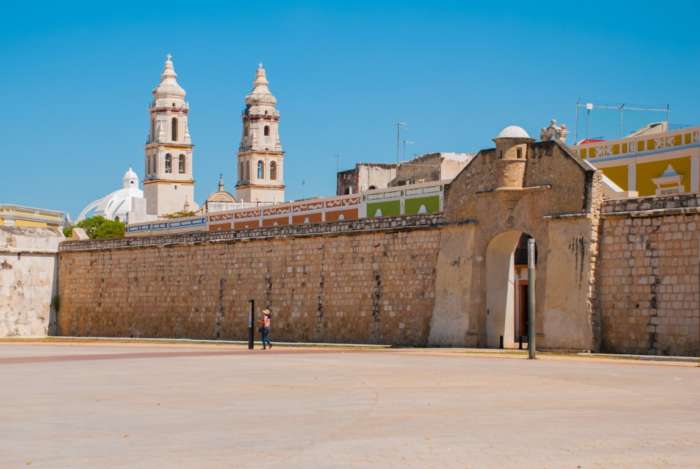Mexico / Itineraries
Mayan Odyssey

This 7 night private tour of the Yucatan Peninsula focuses on the region's Mayan heritage, both in terms of its world-famous ruins as well modern-day Mayan communities and way of life.
-
Day 1 — Cancun
Flights from Europe arrive into Cancun from the late afternoon onwards so, having collected your car at the airport, it’s just a short hop to the suggested Marriott Courtyard for an initial overnight stay.
Suggested Accommodation: Marriott Courtyard Cancun
-
Day 2 — Cancun to Valladolid via Tulum & Coba
After an earlyish breakfast, your Driver / Guide will collect you from the hotel for the beginning of your private tour.
First up, you will head south along the coast to the first of many fascinating Mayan sites, Tulum.
It may be one of the Yucatan’s smallest, and least architecturally impressive Mayan sites, but Tulum sure does pull in the crowds. The perhaps all too obvious explanation as to its popularity lies in both its easily accessible location and stunning setting, looking out over the Caribbean.
One of the last Mayan cities to be established, and primarily the port for the larger inland city of Coba, Tulum was at its height between the 13th & 15th century, shortly before the arrival of the Spanish. Due to its exposed coastal location, Tulum was one of the first Mayan cities to fall and, as with other settlements along the coast, was soon abandoned.
Having spent around 60 – 90 minutes exploring the ruins and taking in the views, you will then head inland to the aforementioned Coba.
It might be just 27 miles inland from the Yucatan Peninsula’s fabled east coast, but the ancient Mayan city of Coba goes relatively unnoticed by the beach brigade.
Coba was first inhabited in around 100 AD and, for the next 500 years, grew largely unchecked with its population peaking at almost 50,000. At this time, long before the now, far more famous Chichen Itza rose to prominence, Coba was the dominant Mayan city in the northern Yucatan Peninsula.
After another 90 plus minutes exploring Coba, you will continue heading inland and to your base for the next 3 nights, the charming colonial town of Valladolid.
There will be time for a brief walking tour of the town’s picturesque, historic centre, after which you are free to relax or go for a further wander on your own.
Suggested Accommodation: Hotel Meson Del Marques Meals Included: Breakfast
-
Day 3 — Valladolid (Day trip to Chichen Itza & Cenote)
In order to avoid both the heat of the day, and the worst of the bus tours that arrive from the coast, we suggest an early start to your exploration of Chichen Itza.
Possibly the most famous archaeological site in Mexico, the UNESCO World Heritage site of Chichen Itza is the most extensively excavated of all the Mayan sites and one could easily spend an entire day exploring its scattered ruins.
Historically, Chichen Itza was something of a late starter, only reaching its peak well after the great Mayan cities of the south, such as Calakmul, Tikal & Palenque, had been largely abandoned. Although Mayan scholars still disagree about exactly who founded the city, the variety of architectural styles point to an ethnic diversity that is hard to find elsewhere.
At the centre of Chichen Itza is its most recognisable structure, the imposing Temple of Kukulkan, also known as El Castillo. This pyramid has precisely 365 steps – 91 steps on each of the 4 sides plus the top platform – all tied in with the Mayan’s incredible understanding of astronomy and most clearly demonstrated on the spring and autumn equinoxes.
After a fascinating but probably quite hot morning spent exploring Chichen Itza, it is just a short drive from the ruins to Yokdzonot, a Mayan ecotourism project created and run by women from the local community. In additional to a tasty, traditional lunch at the simple restaurant, there is also an onsite cenote where you can spend a couple of hours cooling off and relaxing.
Before returning to Valladolid, and enroute, there will still be time for a brief stop in the village of Kaua to visit Pujulá Aldea Maya Viva, a community project designed to introduce visitors to Maya culture and the richness of its traditions.
Suggested Accommodation: Hotel Meson Del Marques Meals Included: Breakfast
-
Day 4 — Valladolid (Day trip to Ek Balam)
Heading north from Valladolid, it is an approximate 45-minute drive to Ek Balam.
Ek Balam can trace its history from around 100 BC to 1500 AD with its heyday from around 700 to 900 AD. By the time of its demise, the city’s population is said to have shrunk to around 10% of its height although, as with other Mayan cities, there is no clear explanation as to why this was.
Unlike nearby Chichen Itza, ‘only’ the centre of Ek Balam has so far been excavated but there is still plenty to see and admire. Thankfully, Ek Balam also receives only a fraction of the number of visitors.
Also unlike Chichen Itza, and many other Mayan sites, it is (for now at least) still possible to climb the site’s main pyramid which, at 95 feet high, is one of the tallest in the Yucatan. Being almost entirely in this part of the region, there are superb views from the top – on a very clear day you might just be able to spot Coba in the distance.
Having enjoyed a leisurely tour of the ruins with your guide, you will then proceed to the nearby village to meet the local Maya community whose home this remains.
Over the next couple of hours or so you will get to meet members of the community, visit a traditional house, learn about how hammocks are made and traditional garments embroidered. You can even try your hand at rolling corn tortillas.
You will then return to Valladolid where the rest of the day is free for you to explore – perhaps visiting Convento San Bernadino – or relax at your hotel.
Suggested Accommodation: Hotel Meson Del Marques Meals Included: Breakfast & Lunch
-
Day 5 — Valladolid to Uxmal via Izamal
Departing Chichen Itza in the morning, you’ll continue your journey west towards one of the Yucatan Peninsula’s most historic towns, Izamal.
Although commonly referred to as a colonial town, the history of Izamal pre-dates the arrival of the Spanish by many hundred years; it is thought that Izamal was founded in the Late Formative Period (750-200 BC) and was then continuously inhabited until the Spanish conquest in the 16th century.
Even today, Izamal is sometimes referred to as the City of Hills, the ‘hills’ in question being the remains of ancient Mayan pyramids. Five of these ‘hills’ are still clearly visible town including the largest, what would have been the pyramid of Kinich Kak Mo, which you can climb for free.
What most people first notice about Izamal however, is the colour of its buildings; the town is also known as the Yellow City as almost every building in the town centre is painted the same, delightful, warm yellow. There is no great historical significance to this, it was simply done to commemorate the Pope’s visit to the town in 1993.
Aside from the old Mayan pyramids, the main attraction in Izamal is the Franciscan convent of San Antonio de Padua which, in keeping with the general practise of the Spanish, was built on top of the original Mayan Acropolis. The atrium to this Convent is only surpassed in size by that of St Peter’s in Vatican City.
Having explored Izamal and had a break for lunch, you will return to the road, skirting around the city of Merida (which can easily be added to this itinerary) before heading south to your base for the next three nights, Uxmal. Arriving in the late afternoon, what remains of the day is free for you to relax by the pool.
Suggested Accommodation: Hacienda Uxmal Meals Included: Breakfast
-
Day 6 — Uxmal (Uxmal ruins and Hacienda Yaxcopoil)
Founded around 700 AD, Uxmal (pronounced Oosh mahl) reached the height of its power towards the end of the 9th century but, by 1200, the city lay largely abandoned, perhaps as a result of the rise of Chichen Itza to the east.
Uxmal’s primary importance comes from the fact that, for most experts, it represents the high-point in Mayan architecture and art. Perhaps no single building better represents this than the magnificent Pyramid of the Magician which, unlike almost every other Mayan pyramid, has a much softer, more cylindrical design.
Other important buildings within the site include the Quadrangle of the Nuns, the Governor’s Palace, the House of the Tortoises and the Ball Court. As with most Mayan sites, much of Uxmal still remains covered by dense vegetation, including the extensive Southern Complex.
As with Chichen Itza (most Mayan sites in fact), it makes sense to visit the ruins of Uxmal as soon as they open, both to take advantage of the cooler weather and to enjoy the lack of crowds. Thankfully, Uxmal receives only a fraction of the number of visitors as Chichen Itza.
After spending the morning visiting the ruins, and a break for lunch, you will set off to visit some further ruins, this time from the Spanish colonial era (yes, temple fatigue is a thing).
Hacienda Yaxcopoil dates back to the 17th century, making it one of the oldest haciendas in the region. While a number of haciendas have now been converted into luxury hotels (including several nearby that we can book), Hacienda Yaxcopoil is an atmospheric, but largely abandoned property, popular with weddings and special events but also open to casual visitors.
Suggested Accommodation: Hacienda Uxmal Meals Included: Breakfast
-
Day 7 — Uxmal (Mun Ha and Puuc Hills)
Heading north from Uxmal, it is a short drive to the outskirts of Muna and the Mirador de Muna, the highest point in a generally flat region, with panoramic views of the surrounding countryside.
More than just a pretty view, the Mirador de Muna is a far broader project that combines traditional Maya culture and natural conservation by means of a near 90 minute walking tour.
With a local, Mayan guide, you will learn all about traditional folklore including a visit to the grotto of the aluxes, mythical beings that inhabit and protect the jungle.
After lunch nearby, you will head back to Uxmal to visit either Kabah or Labna, one of a number of a smaller Mayan sites located within the Puuc Hills.
Suggested Accommodation: Hacienda Uxmal Meals Included: Breakfast
-
Day 8 — Uxmal to Cancun airport / The Beach
Depending on your flight time, you will depart your accommodation in good time for the 5-hour plus drive back to Cancun airport and your return flight home.
Alternatively, for clients looking to extend their stay in the Yucatan Peninsula with time at the beach, we can arrange for you to be dropped off at the beach hotel of your choice. Most beach hotels are located on the east coast, due south of Cancun, although there is also the option of ending your holiday at either El Cuyo or Holbox on the Yucatan Peninsula’s north coast.
(If you are planning to extend your stay, and you’re not in a huge rush to get to the beach, we do have an option – not included – to make your journey back east more interesting!
Having retraced your steps almost as far back as Chichen Itza, you will pass through the town of Piste and head south to Yaxuna (also spelt Yaxunah).
This tiny, Mayan community boasts its very own archaeological site which you might well enjoy all to yourself. As with much of the region, the nearby Lol Ha cenote is ideal for a post exploration cool-off while, for lunch, the village has attracted a degree of international fame via Yaxuna resident Rosalia Chay’s appearance on Netflix’s Chef’s Table BBQ.)
Meals Included: Breakfast
Please Note
This private tour is no more than a sample idea which can be tailor made to your exact requirements, both in terms of the holiday length and itinerary as well as the accommodation.
The 'From price' is for travel in September and is based on two adults sharing the same room throughout. Supplements apply for sole occupancy / transport.
International flights are not included in the price but can be booked by us (ex UK) as part of an ATOL bonded package holiday. Non-flight inclusive holidays are protected under our ABTOT bond.

Beach Extensions
For clients wishing to extend (or even start) their holiday with time at one of the Yucatan Peninsula’s numerous beach resorts there are numerous options. The vast majority of beach hotels are located along the east coast, within easy reach of Cancun airport. Please call or email for advice.

Suggested Accommodation
More Itineraries in Mexico
-
6 Night Tour From Merida
- Merida
- Uxmal
- Izamal
- Chichen Itza
- Valladolid
This 6 night private tour with a driver / guide starts in Merida and takes in Uxmal, Izamal, Chichen Itza, Valladolid, Rio Lagartos & Ek Balam before ending back in Merida or onwards to Cancun airport or the beach.
6 nights Car & Driver / Guidefrom £2175 -
Small Group Mexico Tour
- Valladolid
- Chichen Itza
- Izamal
- Merida
- Uxmal
- Campeche
- Small Group Mexico Tour
- Tulum
Currently Suspended - This 7 Day Mexico Tour is a small group, escorted tour, starting and finishing in Cancun / Riviera Maya and performing a loop of the Yucatan Peninsula. It includes the Mayan sites of Ek Balam, Chichen Itza, Uxmal & Palenque, the colonial towns of Valladolid, Izamal, Merida &...
6 nights Small Group Tourfrom £Suspended -
Mexico Short Break
- Valladolid
- Chichen Itza
- Izamal
This 5 night Mexico short break is built around staying at the delightful Posada San Juan hotel in Valladolid with day trips out to a number of varied, nearby attractions. The itinerary can be lengthened, shortened or amended as per clients' requirements, but not the accommodation.
5 nights Car & Driverfrom £poa -
Yucatan Hacienda Tour
- Valladolid
- Chichen Itza
- Izamal
- Uxmal
- Campeche
- South of Merida
- Merida
This 10 night Hacienda tour takes in most of the highlights of the Yucatan Peninsula, both Mayan & Colonial, using a selection of the region's historic hacienda hotels as your evolving base.
10 nights Car & Driver / Guidefrom £4200 -
The Yucatan Peninsula Loop
- Valladolid
- Chichen Itza
- Izamal
- Merida
- Uxmal
- Campeche
- Laguna Bacalar
- Tulum
Starting and finishing in Cancun, this suggested 2 week long, self-drive itinerary takes in most, if not all, of the key highlights of the Yucatan Peninsula in an anti-clockwise loop of the region. At the end of the itinerary there is the option of extending your holiday at the beach.
14 nights Fly Drivefrom £1950 -
Northern Yucatan Highlights
- Valladolid
- Chichen Itza
- Izamal
- Campeche
- Uxmal
- Merida
Northern Yucatan highlights, this is a 10 night Yucatan holiday. Starting and finishing in Cancun, this suggested 10-night itinerary takes in pretty much all of the key highlights of the northern Yucatan Peninsula, combining Mayan & Colonial sites as well as a taste of the region’s nature-based a...
10 nights Car & Driver / Guidefrom £3200 -
The Yucatan In A Hurry
- Merida
- Uxmal
- Izamal
- Valladolid
- Chichen Itza
5 Night Yucatan Holiday. For those short on time, this brief 5 night itinerary still manages to include many of the highlights of the Yucatan Peninsula combining both ancient Mayan sites and charming, colonial towns as well as a working hacienda.
5 nights Car & Driver / Guidefrom £2100
When to visit Mexico
-
January
0°C -
February
0°C -
March
0°C -
April
0°C -
May
0°C -
June
0°C -
July
0°C -
August
0°C -
September
0°C -
October
0°C -
November
0°C -
December
0°C
You’re in safe hands
When making your travel arrangements, we understand just how important peace-of-mind is. Beyond The Ordinary hold both ATOL & ABTOT bonds so whether you book your flights through us, or independently, any money you pay us is 100% protected. More detailed information on Financial Protection can be found by clicking here.

Make your next holiday Beyond The Ordinary
Whichever of our featured countries you wish to visit, we've been there several times. So, if you're after something beyond the ordinary to Cuba, Guatemala or the Yucatan Peninsula of Mexico, we'd love to hear from you.
Plan my Extraordinary






























